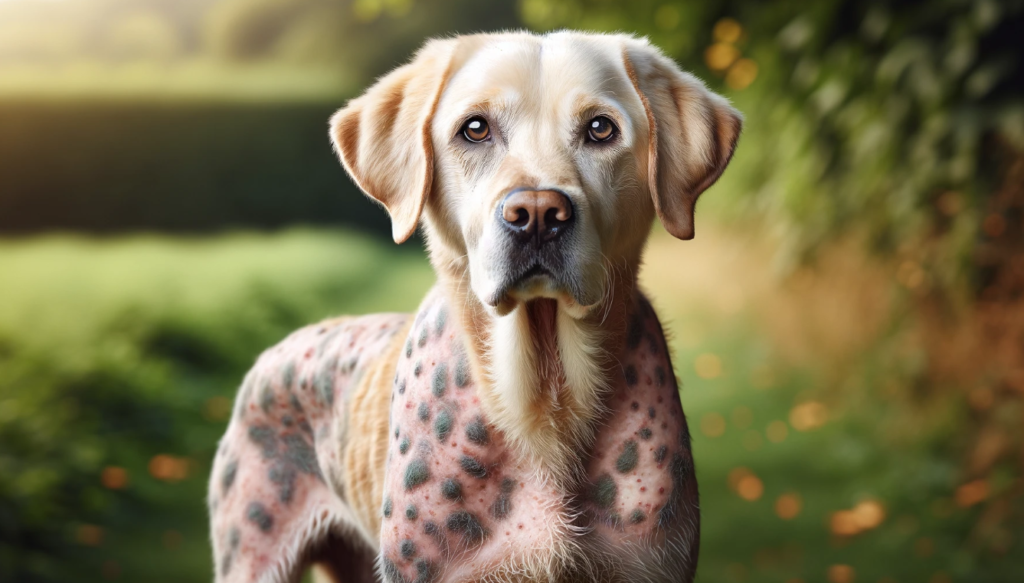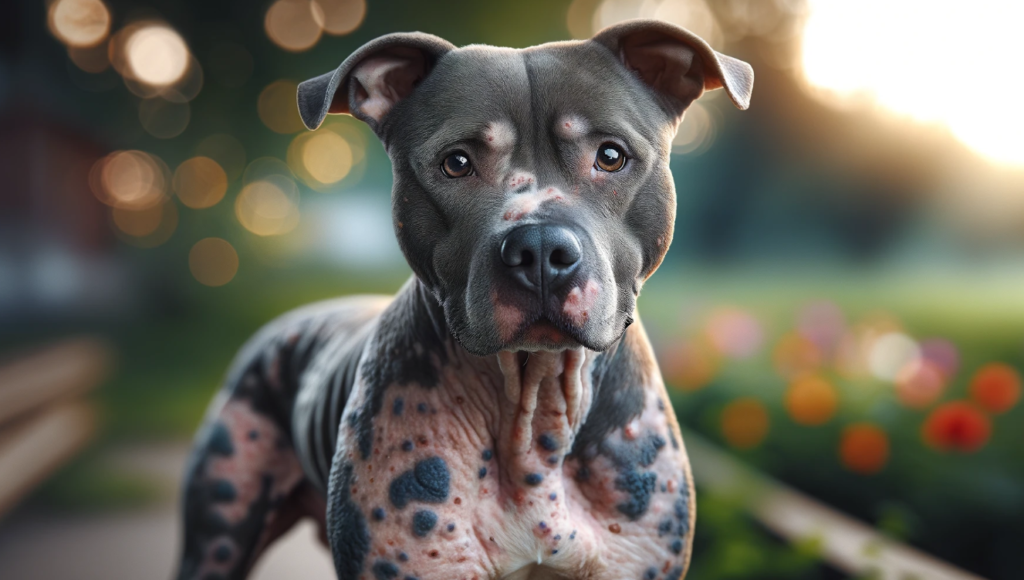As a holistic veterinarian, I understand how distressing it can be when your furry friend isn’t feeling their best. One common but often misunderstood condition in dogs is mange. Diagnosis of mange in dogs is crucial for swift treatment and recovery. This article will guide you through understanding what mange is, its causes, types, symptoms, and most importantly, how to diagnose it.
With my experience and your love for your pet, we’ll work together to ensure your dog’s health and happiness. It’s time to turn your worry into action and help your dog overcome mange. So, let’s dive in and explore everything you need to know about canine mange diagnosis.

Unraveling the mystery of your dog’s incessant itching and discomfort can be a daunting task. Understanding the types of mange that can afflict our furry friends is a crucial step in this journey. Armed with this information, you can better communicate with your vet and ensure your dog gets the best possible care.
Sarcoptic Mange (Scabies)
One common type of mange in dogs is Sarcoptic mange, also known as canine scabies. This highly contagious skin disease is caused by the Sarcoptes scabiei mite, a microscopic parasite that burrows into the skin, causing intense itching, redness, sores, and hair loss. Sarcoptic mange can be easily transmitted between animals, so it’s crucial to keep your dog away from infected animals and environments.
Demodectic Mange (Demodex)
Demodectic mange, or Demodex, is another type of mange that dogs can contract. Unlike Sarcoptic mange, Demodex is not contagious. It is caused by the Demodex canis mite, which naturally lives on the skin of most dogs without causing any issues. However, if a dog’s immune system is compromised or immature, the mite population can multiply, leading to skin irritation, hair loss, and sometimes infections.
Demodex can be localized, affecting small areas of the skin, or generalized, where it spreads across the entire body. Puppies often get localized Demodex, which typically resolves on its own as their immune system matures. Generalized Demodex is more severe and often requires veterinary treatment.
Both Sarcoptic and Demodectic mange can cause significant discomfort and distress in dogs, but with accurate diagnosis and appropriate treatment, most dogs can make a full recovery. The key is to recognize the symptoms early and seek veterinary help promptly. As a caring dog parent, being knowledgeable about the types of mange can help you ensure your dog’s health and happiness. Always remember, when it comes to diagnosis of mange in dogs, early detection and treatment are vital.
Symptoms of Mange in Dogs
As a veterinarian, I can tell you that early diagnosis of mange in dogs is crucial to effective treatment and recovery. Recognizing the symptoms is the first step. Let’s look at the physical and behavioral signs you need to watch for.
Physical Symptoms of Mange in Dogs
Mange can manifest in a variety of physical symptoms in our furry friends. Here are some of the most common ones:
- Intense itching: Mange mites burrow into a dog’s skin, causing severe itchiness. If your dog is excessively scratching, biting, or licking its skin, it could be a sign of mange.
- Redness and inflammation: Mange often results in red, inflamed skin. The affected areas may also feel warm to the touch.
- Hair loss: Dogs with mange often lose hair in patches, especially around the eyes, ears, elbows, and knees.
- Crusty skin: Over time, the skin may become thickened and crusty, especially if the mange is left untreated.
- Sores and lesions: In severe cases, the constant scratching can lead to open sores and lesions, which can get infected if not treated promptly.
Behavioral Symptoms of Mange in Dogs
Besides physical signs, changes in your dog’s behavior can also indicate a diagnosis of mange in dogs. These may include:
- Restlessness: The constant itching can cause your dog to become restless and uncomfortable.
- Loss of appetite: Dogs with mange may lose their appetite, leading to weight loss.
- Changes in temperament: The discomfort caused by mange can lead to changes in your dog’s behavior, such as increased aggression or anxiety.
Remember, early detection is key. If you notice any of these symptoms, you should contact your vet immediately. With prompt diagnosis of mange in dogs, most pets can make a full recovery.
How Mange Affects Dogs
Mange in dogs is not just a simple skin condition. It can have profound effects on your furry friend’s overall health and quality of life. Let’s delve deeper into the impact of mange on dogs:
Impact on Dog’s Health
Mange can lead to a range of health issues in dogs. The persistent itching caused by the mites can result in wounds and secondary infections as your dog scratches and bites at their skin. This can further complicate the diagnosis of mange in dogs as these secondary infections need to be treated alongside the mange itself.
More severe cases of mange, especially untreated ones, can lead to hair loss, crusty sores, and even systemic issues such as fever and lethargy. Dogs with a compromised immune system, whether due to age, illness, or stress, are particularly at risk of severe mange.
Impact on Dog’s Quality of Life
Imagine having a constant itch that you can’t get rid of, coupled with a feeling of general discomfort. That’s what a dog with mange goes through. The incessant itchiness and discomfort can lead to changes in behavior, such as increased agitation, restlessness, and even aggression in some cases.
Furthermore, mange can cause your dog to lose sleep, which can lead to further health complications and a decrease in your dog’s overall wellbeing. It can also affect their appetite and lead to weight loss.
It’s important to remember that mange is not just a cosmetic issue. It can significantly affect your dog’s health and happiness. Early diagnosis of mange in dogs is therefore critical to prevent these complications and ensure your dog can lead a happy, itch-free life.

Diagnosing Mange in Dogs: What to Look For
Recognizing the signs of mange in your furry friend can be the first step towards getting them the help they need. So, let’s talk about how vets diagnose mange in dogs.
Veterinary Examination for Mange
When you take your dog to the vet, they’ll start with a thorough physical examination. They’ll be looking for the tell-tale signs of mange, such as redness, hair loss, and sores. Your vet will also ask about your dog’s history, including any changes in behavior or appetite. This information can help them rule out other conditions that might cause similar symptoms.
During the examination, your vet will likely take a skin scraping. This involves gently scraping a small area of your dog’s skin to collect a sample of cells and mites. This sample will be examined under a microscope to confirm the presence of mites, the cause of mange.
Diagnostic Tests for Mange in Dogs
Beyond the physical examination and skin scraping, there are other diagnostic tests that your vet might use. Here’s what you can expect:
- Trichogram: This is a technique where the vet plucks a few hairs from your dog and examines them under a microscope. This can help them see if mites are present on the hair shafts.
- Blood tests: These can help rule out other conditions that might be causing your dog’s symptoms. They can also give your vet valuable information about your dog’s overall health, which can guide treatment decisions.
- Biopsy: In some cases, your vet might need to take a small sample of your dog’s skin for further examination. This is usually only necessary if the initial tests are inconclusive.
While these tests might sound scary, remember that they’re all designed to help your vet make the most accurate diagnosis possible. And the sooner your dog is diagnosed, the sooner they can start treatment and get back to their happy, healthy self.
So, if you suspect your dog might have mange, don’t hesitate to reach out to your vet. They’re there to help, and they have the tools and knowledge to diagnose mange accurately. Remember, early diagnosis of mange in dogs is crucial to effective treatment and quick recovery.
Treatment Options for Mange in Dogs
If your furry friend has been diagnosed with mange, don’t panic. There are various treatment options available to help them get back to their healthy, happy selves. Remember, the sooner the condition is detected, the easier it will be to treat.
Medications for Mange in Dogs
The most common diagnosis of mange in dogs is typically treated with medications prescribed by a veterinarian. The type of medication will depend on the type of mange your dog has.
- Sarcoptic Mange: This type of mange is often treated with a series of injections or topical applications of medications such as selamectin or ivermectin. These medications are designed to kill the mites causing the mange and alleviate the associated symptoms.
- Demodectic Mange: If your dog has localized demodectic mange, your vet may prescribe a topical solution. However, for generalized demodectic mange, oral medications or medicated baths may be necessary.
Remember, it’s crucial to follow the prescribed treatment plan and complete the full course of medication, even if symptoms seem to improve before the treatment is finished.
Home Remedies for Mange in Dogs
In addition to prescribed medications, there are some home remedies that can be used to relieve your dog’s discomfort. However, it’s essential to consult with your vet before trying any home remedies to ensure they are safe and effective for your dog.
- Borax and Hydrogen Peroxide Bath: A bath made with a mixture of borax and hydrogen peroxide can help kill mites and soothe your dog’s skin. However, be careful not to get the mixture in your dog’s eyes or mouth.
- Apple Cider Vinegar: Diluted apple cider vinegar can be sprayed on your dog’s skin to help kill mites and soothe inflammation. Always dilute the vinegar to avoid irritating your dog’s skin further.
- Aloe Vera: Aloe vera is known for its soothing and healing properties. Applying aloe vera gel to your dog’s skin can help relieve itching and promote healing.
While these home remedies can provide some relief, they should not replace seeking professional medical advice and treatment. Remember, early diagnosis of mange in dogs and proper treatment is the key to your dog’s recovery.

Preventing Mange in Dogs
Regular Dog Care to Prevent Mange
Preventing mange in dogs starts with regular pet care. Remember, a healthy dog is less likely to contract mange. Here are few steps to help safeguard your furry friend:
- Regular Vet Check-ups: Regular vet visits can help identify any health issues early, including signs of mange. Your vet can perform a skin scraping to check for mites.
- <strong>Proper Nutrition: A balanced diet is essential for a strong immune system. Dogs with strong immunity are less likely to develop demodectic mange.
- Hygiene: Regular bathing with dog-friendly shampoos can help keep your dog’s skin healthy and free from mites.
- Regular Grooming: Brushing your dog’s fur regularly can help detect early signs of mange, such as hair loss or skin irritations.
Environmental Changes to Prevent Mange
Maintaining a clean environment is also key in preventing mange. Here are some environmental changes you can make:
- Regular Cleaning: Regularly clean your dog’s bedding and toys. This can help eliminate any mites that may be present.
- Limit Interaction with Infected Dogs: Mange can easily spread from one dog to another. If you know a dog that has mange, limit your dog’s interaction with it until it’s fully treated.
- Preventive Treatments: Use preventive treatments such as spot-on products, sprays, or collars that protect against mites.
Remember, the diagnosis of mange in dogs can be challenging as symptoms may vary and can be similar to other skin conditions. That’s why prevention is key. By providing regular care and maintaining a clean environment, you can help protect your dog from this uncomfortable condition.
Conclusion: Importance of Early Diagnosis of Mange in Dogs
As we come to the end of this guide, it’s essential to emphasize the importance of early diagnosis of mange in dogs. The earlier you can spot the signs and get your canine companion to the vet, the better their chances of a full recovery.
Prognosis for Dogs with Mange
The prognosis for dogs with mange, when detected early and treated appropriately, is generally quite good. With prompt and effective treatment, most dogs can recover fully from mange. However, if left untreated, mange can lead to severe complications, including secondary skin infections and potential systemic issues. In severe cases, it can also be fatal. Hence, early diagnosis and treatment are critical to your dog’s overall health and well-being.
Role of Pet Owners in Mange Diagnosis and Treatment
As a pet owner, you play a crucial role in the diagnosis of mange in dogs. You are the first line of defense in spotting the signs of mange. Noticeable changes, such as excessive scratching, patches of hair loss, or red, inflamed skin, should prompt an immediate visit to the vet. Moreover, following the prescribed treatment protocol and maintaining a clean environment are vital for your dog’s recovery.
Never underestimate the power of preventive measures either. Regular grooming, routine vet check-ups, and a healthy diet can go a long way in preventing mange and other health issues.
Remember, your furry friend relies on you for their health and happiness. Stay alert, act promptly, and give your dog the care they deserve. After all, a healthy dog is a happy dog.
Frequently Asked Questions
Q1: What are the common signs of mange in dogs?
A: The common signs of mange in dogs include intense itching, redness, sores, and hair loss. In severe cases, dogs may also experience restlessness and weight loss.
Q2: How is mange diagnosed in dogs?
A: Mange is usually diagnosed by a vet through a physical examination of your dog. The vet may also take a skin scraping to examine under a microscope for the presence of mites.
Q3: Can mange be treated at home?
A: While there are home remedies available, it is always best to consult with a vet before starting any treatment. Mange can be a serious condition and improper treatment can lead to complications.
Q4: How can I prevent my dog from getting mange?
A: Regular grooming and maintaining your dog’s overall health can help prevent mange. Also, avoid contact with other dogs that are infected with mange.
Q5: Is mange contagious to other pets or humans?
A: Yes, some types of mange are contagious and can be passed to other pets or humans. It’s important to isolate an infected dog until treatment is completed.
